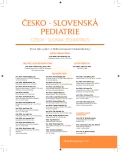Developmental defects of the urinary bladder and abdominal wall
Authors:
J. Morávek; J. Kříž; L. Zeman; M. Pýchová; J. Trachta
Authors‘ workplace:
Klinika dětské chirurgie UK 2. LF a FN Motol, Praha
přednosta prof. MUDr. J. Šnajdauf, DrSc.
Published in:
Čes-slov Pediat 2014; 69 (6): 331-337.
Category:
Original Papers
Overview
Objective:
The aim is to evaluate the results of treatment of patients with penopubic epispadias, exstrophy of the urinary bladder and cloacal exstrophy.
Material and methods:
Between 1994–2013 there were 3 patients with epispadias, 25 with bladder exstrophy and 6 with cloacal exstrophy operated on at our institution. 94 surgical procedures were performed. Reconstruction of the urinary bladder was done 24–48 hours postnatally, 3x with pelvic osteotomy. In cloacal exstrophy the bladder was reconstructed from two hemibladders together with omphalocele plasty and colostomy of the large intestine stump. Reconstruction of the epispadiac urethra was performed in toddler age. 3rd phase of reconstruction was shifted to prepubertal and pubertal age with reimplantation of the ureters to eliminate vesicoureteral reflux and Young–Dees–Leadbetter procedure to increase bladder outlet resistance so as to achieve socially acceptable state of continence.
Results:
We have faced following complications: one death of intractable sepsis in a child with cloacal exstrophy and other associated developmental defects. One decreased function on the kidney on renal scan (30%) despite succesfull surgical correction of VUR. One recurrent bladder dehiscence + pyohydronephrosis bilaterally. One mechanical intestinal obstruction in a girl with cloacal exstrophy and duplex uterus the right one with dystopic ureter. Five times urethrocutaneous fistula in the bladder neck.
Conclusion:
Bladder reconstruction is technically possible even with very small bladder targets. The bladder tends to expand and enlarge its capacity where the initial capacity was a few cc., despite initial incontinence. Socially acceptable continence has been reached in our cohort of patients in 40% of cases with bladder exstrophy. In case of permanent incontinence the solution is bladder augmentation and catheterisable stoma. Good preservation of renal function is the rule, fertility is rather exceptional.
Key words:
complex exstrophy – epispadias, cloacal exstrophy, incontinence, reconstruction
Sources
1. Kelly JH. Vesical exstrophy:repair using radical mobilisation of soft tissues. Pediatr Surg Int 1995; 10 : 298–304.
2. Jarzebowski AC, McMullin ND, Grover SR, et al. The Kelly technique of bladder exstrophy repair: continence, cosmesis and pelvic organ prolapse outcomes. J Urol 2009; 182 : 1802–1806.
3. Ansari MS, Cervellione RM, Gearhart JP. Sexual function and fertility issues in case of exstrophy epispadias komplex. Indian J Urol 2010; 26 (4): 595–597.
4. Ben-Chaim J, Docimo SG, Jeffs RD, et al. Bladder exstrophy from childhood into adult life. J R Soc Med 1996; 89 (1): 39–46.
5. Bhatnagar V. Bladder exstrophy: An overview of the surgical management. J Indian Assoc Pediatr Surg 2011; 16 (3): 81–87.
6. Šnajdauf J, Škába R, et al. Dětská chirurgie. 1. vyd. Praha: Galén, 2005, Karolinum, 2005 : 209, 353.
7. Arena S, Dickson AP, Cervellione RM. Relatioship between the size of the bladder template and the subsequent bladder capacity in bladder exstrophy. J Pediatr Surg 2012 Feb; 47 (2): 380–382.
8. Gearhart JP. Complete repair of bladder exstrophy in the newborn: complications and management. J Urol 2001; 165 (6 Pt 2): 2431–2433.
9. Shah BB, Massanyi EZ, Dicarlo H, et al. Role of urethral buking agents in epispadias-exstrophy complex patients. J Pediatr Urol 2014 Feb; 10 (1): 176–180.
10. Baka-Ostrowska M, Kowalczyk K, Felberg K, et al. Complications after primary bladder exstrophy closure – role of pelvic osteotomy. Cent Eur J Urol 2013; 66 (1): 104–108.
11. Mushtaq I, Garriboli H, Smeulders N, et al. Primary bladder exstrophy closure in neonates: challenging the traditions. J Urol 2014 Jan; 191 (1): 193–197.
12. Schaefer AJ, Purves JT, King JA, et al. Complications of primary bladder closure of classic bladder exstrophy. J Urol 2008 Oct; 180 (4 Suppl): 1671–1674.
13. Gargollo PC, Borer JG, Diamond DA, et al. Prospective follow up in patients after complete primary repair of bladder exstrophy. J Urol 2008 Oct; 180 (4 Suppl): 1665–1670.
14. Shaw MB, Rink RC, Kaefer M, et al. Continence and classic bladder exstrophy treated with staged repair. J Urol 2004 Oct; 172 (4 Pt 1): 1450–1453.
15. Capolicchio G, McLorie GA, Farhat W, et al. A population based analysis of continence outcomes and bladder exstrophy. J Urol 2001 Jun; 165 (6 Pt 2): 2418–2421.
16. Novák I, Broďák M, Stefan H. Komplex exstrofie-epispadie: závažná vrozená vývojová vada močové soustavy. Urol pro Praxi 2009; 10 (5): 294–296.
17. Zerhau P, Hnilička B. Primární rekonstrukce exstrofie močového měchýře u dívek s použitím paraexstrofic-kých kožních laloků. Česká urologie 2000; 2 : 34–38.
18. Novák K, Kočvara R, Dítě Z, et al. Chirurgická úprava hrdla močového měchýře u dětí a dospívajících. Česká urologie 1999; 3 : 30–34.
Labels
Neonatology Paediatrics General practitioner for children and adolescentsArticle was published in
Czech-Slovak Pediatrics

2014 Issue 6
Most read in this issue
- Dextromethorphan in the hands of a teenager – cheap and legal ticket on a „trip“
- Neonatal hemochromatosis associated with renal tubular dysgenesis
-
Onychomadesis po onemocnění ruka-noha-ústa
(hand-foot-mouth disease) - Refeeding syndrome in childhood
